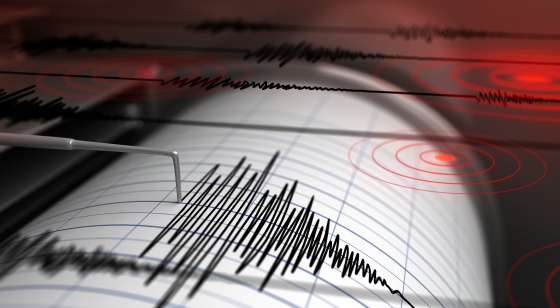
TRUMP SAYS: HUNTER MAKES FORTUNE FROM SHADY DEALS!
BIDEN FAMILY STINKS TO HIGH HEAVENS OF CORRUPTION!
DON'T GET LEFT OUT: HUNTER MUST BE STOPPED!

This article was originally published by Daisy Luther at The Organic Prepper

If you were caught up in the midst of a massive earthquake – the kind that takes down buildings and buckles roads – would you know what to do?
I’m not talking about a minor temblor that shakes a glass off the counter and sends it to shatter on the floor.
I’m talking about The Big One. The one for which we are long overdue. The one that experts are predicting could happen at any moment.
The United States has several active fault zones, and some of them are capable of producing extremely destructive quakes. While most people think of the West Coast (and for excellent reason), there are massive faults in other places in the US, too.
ALL of these fault lines have ruptured before, and they will rupture again. In fact, according to this map, more than half of the continental US could expect a major quake within the next 50 years.

Photo Credit: National Geographic
And that is just the continental United States. Alaska is at a very high risk of earthquakes and Hawaii is in danger from tsunamis due to earthquakes in other parts of the Pacific.
National Geographic summarizes the risk:
…while all U.S. states have some potential for earthquakes, 42 of the 50 states “have a reasonable chance of experiencing damaging ground shaking from an earthquake in 50 years,” which is generally considered the typical lifetime of a building. Sixteen of those states have a “relatively high likelihood” of damaging shaking.
With those odds, it’s pretty likely that most of us will experience a significant earthquake in our lifetime.
This article isn’t about the long-term aftermath of an earthquake, during which you’d be unlikely to have power, safe water, or access to the stores for supplies. It’s about surviving the event itself.
For more information on general survival and preparedness, go here to get a free self-reliance library and daily email updates.
Here’s how to survive an earthquake.
So what should you do when the ground starts shaking?
It depends on where you are. We’ll go over three different scenarios. It’s critical to note that sometimes people are just in the wrong place at the wrong time and that the situation will be very fluid. Be ready to adapt quickly if plan A doesn’t work. (Check out this article on the three steps to survival.)
Standard advice is to
Depending on the severity of the earthquake you may not get emergency announcements advising of evacuation routes or refuge centers. The emergency services themselves may be unable to function, and communications may be down.
You could be on your own for a considerable length of time before rescuers get to you. It’s vital to think clearly and logically, which is not always easy in an emergency situation. That’s why it’s important to think these things through ahead of time – so that you’ve already made many of the necessary decisions well before the first sign of a tremor.
What to do if you’re outside during an earthquake
If you’re outside the biggest risk is being hit by something that has been structurally damaged by the quake.
What to do if you’re at the beach during an earthquake
The biggest danger of experiencing an earthquake when you’re at the beach is during the aftermath. A tsunami can travel as far as 10 miles inland, wiping out everything in its path. You will have no way of knowing where the epicenter of the quake was. The highest risk occurs when the epicenter is at sea. Here’s a quick tsunami primer:
Most tsunamis are caused by earthquakes. As a result, most tsunamis occur near or at fault lines. When a tsunami is generated, it is not only 1 wave. Instead it is a series of waves, known as a wave train. These waves travel together and can be up to 1 hour apart. Tsunami waves travel extremely fast with speeds of up to 500 miles per hour—the speed of a jet.
They can be as wide as 60 miles and cross entire oceans without losing momentum. When a tsunami is traveling, it may be less than a foot in height. This causes it to be unnoticed by sailors who are at sea. As the tsunami approaches land, it hits shallow water and begins to slow down. The top of the wave, however, continues travelling, causing the sea to rise dramatically. Tsunamis are extremely destructive on land. The waves can surge up to 100 feet in height and completely devastate a coastal area. (source)
Tsunami waves travel at hundreds of miles per hour. You must act immediately.
After the initial wave, it is extremely likely that more will follow. These waves can be up to an hour apart. Do not return to lower ground until officials have given the all-clear.
What to do if you’re indoors during an earthquake
If you are inside when a quake occurs, your priority is to protect yourself until you can escape the building.
If you are at home when disaster strikes, the same rules apply. Don’t let familiarity with your surroundings lull you into a false sense of security.
The danger of aftershocks
Remember that aftershocks can often be as powerful (or even more so) as the initial event. There is no reliable way to predict how soon those shocks will arrive.
What to do immediately after the earthquake
As soon as the shaking stops you need to assess your situation as quickly and calmly as possible.
How to safely evacuate after an earthquake
If you need to leave the immediate area, there are a few things to keep in mind to travel safely.
Have you ever been in a major earthquake?
Do you have any tips that should be added to this article? Have you got any stories of your experiences during or after an earthquake? Share them in the comments section below.
More about earthquakes:
Full-Rip 9.0: The Next Big One
Cascadia (a novel about a massive earthquake in the PNW – great read!)
San Andreas for Preppers: 12 Earthquake Survival Lessons from the Movie
Please feel free to share any information from this article in part or in full, giving credit to the author and including a link to The Organic Prepper and the following bio.
Daisy is a coffee-swigging, gun-toting, homeschooling blogger who writes about current events, preparedness, frugality, and the pursuit of liberty on her websites, The Organic Prepper and DaisyLuther.com She is the author of 4 books and the co-founder of Preppers University, where she teaches intensive preparedness courses in a live online classroom setting. You can follow her on Facebook, Pinterest, and Twitter,.

It Took 22 Years to Get to This Point
Iowa's Johnson County Health Department is pushing the flu vaccine, claiming that it will prevent...
Most of us have heard of germ theory ad nauseam since the beginning of the COVID-19 scamdemic....
This article was originally published by Willow Tohi at Natural News. The Biden administration...
Renowned award-winning computer scientist Yoshua Bengio has warned that artificial intelligence...
Commenting Policy:
Some comments on this web site are automatically moderated through our Spam protection systems. Please be patient if your comment isn’t immediately available. We’re not trying to censor you, the system just wants to make sure you’re not a robot posting random spam.
This website thrives because of its community. While we support lively debates and understand that people get excited, frustrated or angry at times, we ask that the conversation remain civil. Racism, to include any religious affiliation, will not be tolerated on this site, including the disparagement of people in the comments section.


Great article, Daisy.
I have since moved out of CA but was living in the SF Bay Area during the October 1989 earthquake. I was at work in downtown SF when it hit. Took me 6 hours to get home. The whole experience was very traumatic. At least my home only sustained minor damage.
They have a saying there, “Earthquakes themselves don’t kill people. The collapsing buildings and flying debris kills people.”
IMHO The most important thing to do is to keep heavy objects low and or secured to the wall. For example an old fashioned television on a piece of furniture. If the kids sit on the floor beneath the ? tv they could be injured ? or even killed. Secure tall bookshelves to the wall.
After a major quake gas lines can be a problem. Water tanks need to be attached to the wall.
In quake areas like California, building codes require structures to be earthquake safe. Old ? homes are still vulnerable so stay in an archway.
_
Is the Beverly Hillbillies mansion EQ proofed?
shut off power and gas IMMEDIATELY. fire will be of utmost concern.
What would I do? Reach for another cold beer or quart of shine.
well try a snort of this, and pass the peace pipe. this should be a good show.
Ya me too lol. I live in farm country, no big buildings etc. If I was in town I would film it for future entertainment! 😛
Another good tip if indoors is to lay alongside strong solid objects (like a couch). There is a triangle there that is known as the survival zone. This may in some respects be better than getting underneath a table or some such thing.
Back in the eighties, I attended a government workshop on earthquake preparation and mitigation. At that time, the public official stated that nearly every state was at risk of some earthquake potential damage as there are innumerable fault lines and active seismic zones well beyond those in the public awareness. And over decades many have become active by either unknown means or fracking causing mini-earthquakes.
What the official stated at that time was that priority would be given to the larger metropolitan zones due to huge loss of infrastructure and life coupled with human misery and suffering from clean uncontaminated water and loss of transported food and medications and medical supplies.
Now it’s a thousand times worse due to Just in Time manufacturing and inventory controls. The very first hurdle would be loss of chlorination due to an 11-14 day routine inventory for city and county water purification. Now imagine a draw down over a geographic zone with a major earthquake in which not only the many regions of a metro area lack potable water but all of the suburbs, villages, outlying towns and cities likewise have no access to chlorine.
Look to any coverage of hurricane affected zones over the last decade and FEMA mitigation. What becomes evident is FEMA does not stockpile and rotate basic things like bottled water. Which means after a tragedy strikes, then they place bids, and these then are fulfilled, and this causes delays. Typically bottling and canning beverage companies like breweries can bottle and can water…and the patriotic ones bail the government out…over and over.
I was in Haiti very soon after the quake in 2010. People told me they could not stand up nor walk within their homes during the quake that lasted over forty seconds. All they could do was hang on to a post, wall or anything they could find. Many of the concrete houses pancaked down on themselves. Over two hundred thousand deaths. I agree with all of the article above, but some situations will not be survivable
If there is a major earthquake, the most devastated regions of it will revert (especially now)to the Walking Dead/Resident Evil/Dawn of the Dead kind of scenario where all the Freebies R Us and unprepared crowds will within hours turn into ENTITLED COMMUNIST COLLECTIVIST GIMME DATS thieving looting mobs that should be treated as such as those movies did. Get a high cozy perch and play lets tag a headshot as the looters roll on in.
Under crisis conditions like an earthquake, then the immediate problems are injuries that cannot be treated in the typical manner as public services cannot transport them nor handle the overload. Then they lack supplies, personnel, and medicines.
Fire stations are prone to collapse as one side has to open to admit and release engines, thus that side has weaker structural integrity. There is a genuine risk that collapse may occr trapping engines inside as well as massive flooding from water leaks throughout the region thus an inability to have adequate pressure to control blazes. Fire, earthquake, and exposure to the elements all goes together. Soil liquifaction can destroy structural integrity of compromise it as well as venting issues for fireplaces.
What they told us was bridges may stand but the roads leading up to and ground the bridges may collapse. And so that fact will severely affect transportation. Likely the best case scenario is vastly increasing river barge traffic to get critical supplies in on a new routine basis as roads and rail may be disrupted.
Fuel shortages would result in commandeering for military and first responder use. This bodes badly for survivors especially if winter is approaching. You get into a situation where you would essentially be forming a refugee camp with seasoned firewood access and trying to keep them warm enough to offset inevitable contagion from poor sanitation, restricted water use, poor nutrition, and cold weather.
Like most disasters, your best option is being rural. Urban areas would be horrific with stupid decisions contributing to the suffering like ingesting tainted water and mortality from stomach flu in the immune compromised.
I thought about this, when walking my dog past a big box store.
There is enough room for semi to drive through, and make a delivery, around back.
You are walking between one cinderblock wall, one layer thick, 15-20ft high, and the side of the store, of similar construction.
If both walls were to come together, there would not be enough room to stand.
In my experience, as security, the country was literally built on narcotics and migrants, many of whom could not install conduits and ducting, in a straight line. Think about that, and look up.